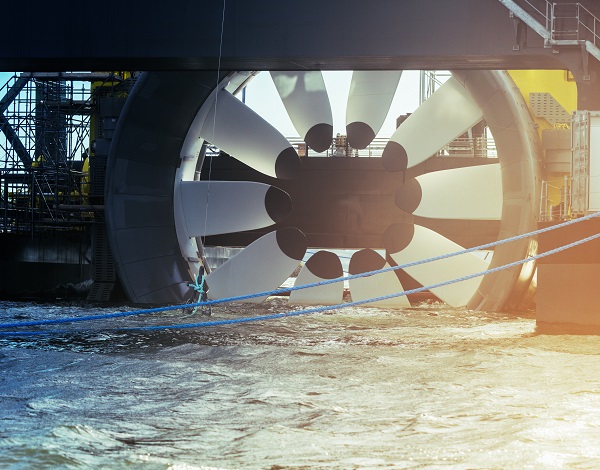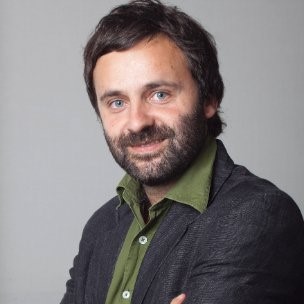admin | 11/09/2019
There are numerous alternatives for producing sustainable energy and they are being used around the world in order to ensure that by 2050 100% of production is done with renewable resources. This type of energy is becoming an essential aspect to achieving this goal, at least in Europe, which is leading research and development of marine energy. It also has an obvious advantage: its abundance. Seventy percent of the planet’s surface is covered in water and 97% of this water comes from seas and oceans, so institutions and companies are already cooperating at a global scale to leverage its potential.
Marine energy is a set of technologies that harness the power of the oceans. Experts distinguish between two types of marine energy: on the one hand, ocean energy, which is extracted from the sea (waves, tides, currents, thermal, salinity gradient); and on the other, wind energy (offshore, onshore).
In the oceanic energies we can distinguish
– Wave power. This leverages the movement of masses of water. Different converters have been developed: floating (Pelamis and floating buoys), which can be anchored to the coast (oscillating water column, OWC) or to the ocean floor.
– Marine and tidal current energy. This leverages the natural movement of water as it increases (high tide) and decreases (low tide).
– Thermal gradient power. This converts ocean thermal energy thanks to the temperature difference between the surface, which is heated by the sun, and the cold depths.
– Salinity gradient power. This is the energy obtained from the difference in the salt concentration between seawater and river water.
– Wind energy. This may be offshore, with fixed foundations, or deepwater floating solutions.
Beñat Sanz, the specialist co-manager of the marine section of the Association of Renewable Energy Companies (APPA), underlined that the latter has seen the most progress recently, thanks to the large number of private and public investors all over the world committing to this resource as a result of its potential. Deepwater areas are home to around 80% of the planet’s wind resources, which is generating interest in creating floating platforms: “There is a lot of high-quality wind over the ocean, because there are no obstacles,” he said.
With regard to ocean energy, he stressed that although research has been going on for years, strong investment is not currently being made, and while offshore wind farms are being built, they are mainly progressing for the time being in the development of devices “with technology that can withstand such a complex environment.” “Development is slow, but it has a great deal of potential. By 2050, it is expected that 10% of all of Europe’s energy supply will come from ocean energy, especially from waves and currents,” he explained.
In fact, the International Energy Agency (IEA) forecasts that power generation from only waves and tides will increase from just under 1 TWh in 2010 to almost 60 TWh in 2035, with an installed capacity that will grow from less than 1 GW to 15 GW. This will lead to the creation of a new industrial sector firmly tied to Europe and 400,000 skilled jobs across the supply chain.
The development of this energy requires clear involvement from countries, both in terms of investment and in simplifying processes and establishing appealing regulatory frameworks
Government involvement
In order to achieve this, a number of barriers must be overcome. One of the main barriers, according to Sanz, is technological development. Marine energy is currently at a crossroads, with many projects underway, but no technology clearly leading the pack. Some technologies have also failed to demonstrate their effectiveness. Devices still need to be truly made to last in real conditions. In fact, current research is headed in that direction, aimed at developing efficient and robust devices that will last the course of a 15-year project.
It must not be forgotten that the marine environment is aggressive and complicated. This, in addition to its enormous scale means developing these initiatives requires strong investment, so “a continued commitment to this technology from countries” is essential. That’s why the APPA specialist recognizes that, although the EU has already established a strategy to drive the sector, specific country involvement is required not only in the field of funding, but also with regard to facilitating project launches. He therefore calls for inter-ministerial coordination and the simplification of permits and processes to lighten the long list of administrative requirements and to reduce times, as the novelty of the initiatives creates long waits due to lack of understanding of their operability. He thus advocates for establishing a specific and appealing regulatory framework to implement pilot projects and the first demonstration projects.
Beñat Sanz believes that only with the clear involvement of governments and public administrations and the creation of specific R&D+i funds in the realm of marine renewables will the main challenge facing this technology be overcome, which is the “necessary reduction of costs to obtain a competitive LCOE (levelized cost of energy)” and guarantee the effectiveness of an installation in marine energy. “Specific goals must be set that will incentivize technologists and trailblazing companies throughout their entire supply chain,” he says.
Europe is leading development
There is no doubt that these incredibly complex, large-scale initiatives are generating growing international cooperation, since, as Beñat Sanz notes, “a single country or company cannot execute such complex projects.”
There are international institutions attempting to create a critical mass and advances in marine technology, such as Ocean Energy Europe (OEE), WindEurope, ETIP Ocean, and the International Energy Agency-Ocean Energy Systems (IEA-OES). The European Commission is also developing the Blue Growth strategy to support the sustainable growth of the marine and maritime sectors, and there are several European programs underway with open calls to facilitate technology developers’ access to testing centers.
Nevertheless, today European companies are leading research and development in marine energy, representing 66% of the world’s marine energy patents and 44% of its wave energy patents. In fact, the majority of the projects carried out outside of Europe, in Canada and Southeast Asia, use European technology.

By 2050, 10% of all of Europe’s energy will come from marine energy
One example of this is Statoil’s Hywind project, the world’s first floating wind farm, located in the North Sea, 25 kilometers off the coast of Scotland. Its floating structures were manufactured in Navantia’s Fene (A Coruña) facilities.
Also of note are European tidal power plant projects such as the French company La Rance’s plant, which has been operating since 1966 and supplies power to Brittany; Tidal Lagoon, whose construction is expected to be completed in 2022 and is expected to generate 8% of the United Kingdom’s power supply; and MeyGen (Scotland), which is currently the largest tidal turbine power project in the world in the development phase. In Spain, the Magallanes initiative on the Galician coast stands out and is the country’s largest tidal power development. It is currently in the final installation phase.
Other parts of the world such as South Korea, Canada, Australia, and Latin America are investing heavily in the development of this energy and notably progressing in this area. Chile stands out with research projects implemented all along its 4,000 kilometers of continental coast thanks to the Center for Marine Energy Research and Innovation, promoted by the Ministry of Energy and supported by national companies and universities. In Brazil, the National Electrical Energy Agency installed a prototype on the coast of the state of Ceará to generate power with waves, and the Israeli company Eco Solutions is developing devices to capture wave energy with buoys, a similar procedure to the one used in the Southern Ocean in Argentina to generate power from currents and tides. Mexico has already approved the installation of the first wave power plant in Colima, promoted by the company Eco Wave Power México.
Complimentary to other renewables
The globalization of marine energy projects is feasible given its usage prospects. By 2050, the global market is expected to reach 53 billion euros per year, according to the organization Ocean Energy Europe. The European forecast for 2050 is that 100% of energy will be renewable, so “committing to the ocean to compliment other energy resources” will be essential. Marine energy really has a great deal of potential:
– It is a predictable and highly prevalent resource: the location of tides and currents is well known, while wind and sun are much more difficult to control.
– It has a limited environmental impact and minimal visual impact, in addition to being silent and not installed in populated areas.
– It is compatible with wind and solar photovoltaic power, making it one piece of the puzzle to progressing toward a 100% renewable energy matrix.
– It is very appealing at the industrial level, as companies must participate a great deal for its development, involving industries from different sectors carrying out large, complex projects. It will also revive the maritime industry.
– Water is 1,000 times thicker than air, so electricity can be produced at low velocity, depending on the type of infrastructure. Power can be generated even at speeds of 1 m/s.
Figure 1
Evolution of Marine Energy Projects between 1964 and 2040 (by Type and Location)

Source: “Market Study on Ocean Energy,” by the European Commission (2018)
This article was written with the participation of…

Beñat Sanz Antoñanzas studied Environmental Science at the University of Alcalá (UAH) and started working at the Association of Renewable Energy Companies (APPA) in October 2008 as a specialist in the Marine and Tidal Energy sections. He is now the head of the Marine Energy Area of the APPA, where he attempts to boost, coordinate, and strengthen the national renewable marine energy industry.
Over the years he has managed all kinds of projects related to renewable energy, organizing events to gather industry players, participating in forums and defending the partners’ perspective, moderating sector forums, and writing articles to show the potential and opportunities available in the national RME field.
He has worked hand in hand with the three presidents that have represented the marine section of the APPA since its creation and has been present at all levels of decision-making in order to give greater visibility to Spanish marine energy and thus drive a sector with an excellent scientific, technological, and industrial fabric whose participation will be key to the growth and consolidation of these technologies.





